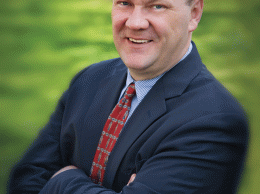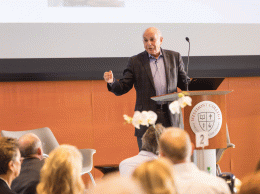Energy efficiency was the hot topic at Eco:comics, the Wall Street Journal’s annual conference on green business. The three-day conference, held March 20-23, again took place at Bacara Resort & Spa in Goleta this year.
A quick informal poll of the audience at the invitation-only conference revealed a strong preference for energy efficiency technology: Out of seven other options, 46 percent of participants said they’d be most likely to invest in the sector as opposed to solar, wind and other green business industries.
Here’s a look at some of the highlight sessions at the event:
Green cities: Pipe dream or reality?
How can big cities become sustainable?
That was the question for Richard Daley, former mayor of Chicago, and William McDonough, an architect and expert in sustainable development.
“We need a bigger plan,” McDonough said, explaining that the problem with transforming major cities into green ones isn’t a lack of resources — it’s the absence of a national plan. Daley echoed the sentiment and told the crowd that creating sustainable programs is currently in the hands of city governments and nonprofit organizations.
Daley, who served as Chicago’s mayor from 1989 to 2011, said it’s important for civic leaders to explain to their constituents why conservation is important and what the city is doing about it. “You have to lead by example,” he said. For example, once leaders explain how trees contribute to air quality, more people are likely to plant trees.
Daley and McDonough agreed that the best way to start building sustainable cities is to form committees and start making a long-term plan. “Start with the kids,” McDonough said. “What jobs do they want? What hopes to they have? It all starts there.”
Natural gas bonanza
With unprecedented levels of natural gas being produced in the U.S., the CEO of a major energy company discussed various ways to take advantage of the huge supply.
“We have to do something with natural gas to make sure it’s sustained,” Thomas Farrell, president and CEO of Virginia-based Dominion Resources, said during a panel on the natural gas bonanza. “There’s a lot of gas … There’s an ocean of gas.”
Farrell told the crowd that the country is currently producing 33 trillion cubic feet of natural gas. To put that number in perspective, 30 trillion cubic feet of natural gas could meet the country’s needs for power generation, transportation, exportation and manufacturing.
Many industry insiders favor exporting some of the natural gas to other countries while using some of it inside the U.S. Wall Street Journal Reporter Russell Gold said a recent survey asked people in the industry whether the influx of natural gas should be used for power generation, transportation, exportation, manufacturing or all of the above. “The clear winner was ‘all of the above,’” Gold said.
A new “Middle East”
Natural gas isn’t the U.S.’ only growing resource. Oil production in the U.S. is on the rise, with experts predicting that the U.S. may pump more barrels than Saudi Arabia within the next decade.
Marvin Odum, president of Shell Oil Co., was on hand to discuss the implications of the big supply of gas and oil. Although the oil numbers are likely to increase to 3 million barrels a day in coming years, he said,
“We’re still going to care what happens in the Middle East.” According to Odum, there’s a large global market for oil, and the U.S. is still early in its development as an exporter. “We have quite a bit more work to do,” he said.
Tackling the threats facing humanity
Larry Brilliant, CEO and president of the Skole Global Threats Fund, said his organization is looking for solutions to several major global issues, including disease pandemics, climate change, war and water shortages, many of which are interconnected issues.
“It’s a combination of low-probability, high-consequence events that modernity is pushing forward,” said Brilliant, a physician and epidemiologist by education who previously worked for Google as the director of its philanthropic arm.
The Skole Global Threats Fund has a $150 million budget for the next five years, he said.
The group has tapped into so-called big data to tackle many of the issues. Working with such data, epidemiologists are increasingly able to accurately predict where disease epidemics may arise, and their potential severity. Brilliant said that 15 years ago, it took 165 days to identify a potential pandemic outbreak. That number is now down to 15 days.
Climate change is the “great exacerbator,” Brilliant said, saying that it contributes to pandemics and water shortages, and could even be a source of strife among nations. Pakistan’s entire food supply is “dependent on two other nuclear-armed countries,” he said.
One audience member at the conference asked Brilliant if he saw ways for private, for-profit companies to address any of these issues. Brilliant said there is, particularly for high-tech companies. “There’s a tremendous amount of money to be made with big data,” he said. Development of new drugs and medicines also present market opportunities, he said.
What investors want
Venture capitalists Josh Green of Mohr Davidow Ventures and Alan Salzman of VantagePoint Capital Partners sparked a lively debate on the future of LED lights and electric cars and talked about the current dearth of funding for clean energy and green business startups.
Green said that venture capitalists have started to focus more on “capital light” opportunities including Internet-based companies rather than on hardware-heavy, cash-intensive startups.
Something with a “low capital investment and fairly quick payoff” is what he and his peers are interested in these days, Green said.
“For today’s financial capital-raising environment,” financiers are “focusing on the problems, but not necessarily the ‘big’ problems,” he said.
Salzman said there are still opportunities to solve some of the big issues surrounding energy storage. “The big sea change, really, that will come with wind” is enhancing storage capabilities, he said.
“This decade, I think you’ll see significant deployment of cost-effective utility grade energy storage,” Salzman said.
He also offered another prediction: That Americans will have made the switch, 100 percent, to LED lights by 2020.
While both venture capitalists are invested in LED technology, Green disagreed strongly with Salzman’s prediction on the time frame for adoption. He said it will take some time for the shift from incandescent bulbs to occur, and that it will be predicated on a boom in new housing. By 2020, expect LEDs to occupy about 30 to 40 percent of the market, Green said.
A quick audience poll showed exactly half agreed with Green’s prediction, and half with Salzman’s.
LEDs have a higher up-front costs but can last for decades, as compared to several years for traditional light bulbs.
“After the first big wave of changeover to LEDs, people will start looking into features such as being able to change room ambience, temperature, color with light, et cetera,” Salzman said.
Green said his firm is not an investor in electric car company Tesla, but praised it as “truly a transformative company.”






 Print
Print Email
Email
















